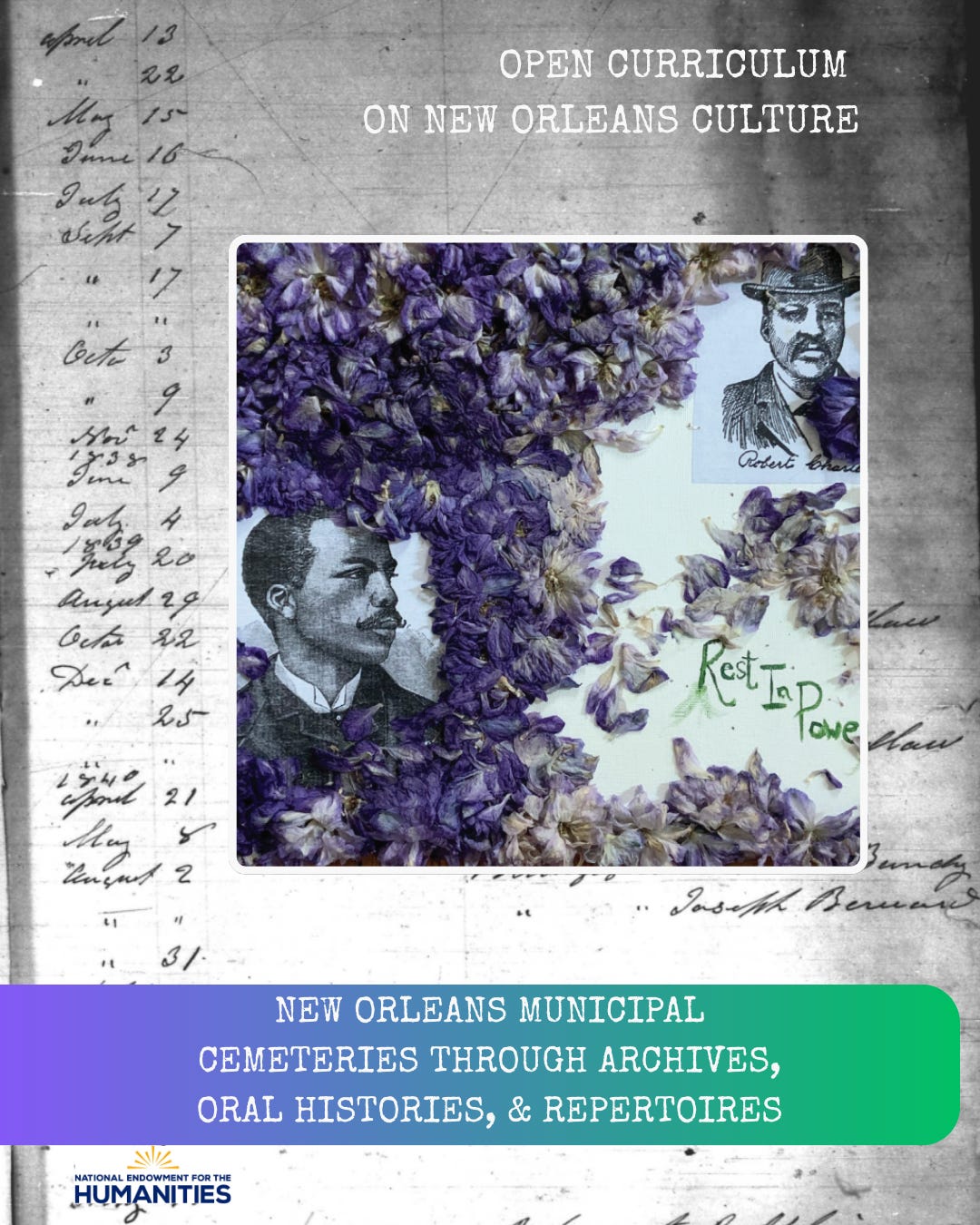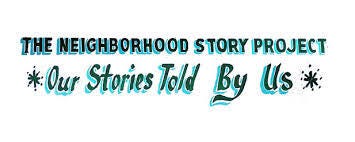Celebrating an Open Curriculum for New Orleans Culture (NEH)
Celebrating the brilliance of New Orleans life and culture and the importance of the National Endowment for the Humanities
This week, on the LifexCode socials, we celebrated one of our NEH-funded LifexCode projects and collaborations: the Open Curriculum for New Orleans Culture.
Funded by a National Endowment for the Humanities grant in 2022, and led by Principal Investigator Dr. Bryan Wagner (UC-Berkeley) and Co-PI Jessica Marie Johnson (JHU), OCNOC sponsored collaborations with the Diaspora Solidarities Lab, LifexCode, the Neighborhood Story Project, and individual artists and cultural workers across New Orleans.
The result was hundreds of open access resources, all available for teaching and sharing thanks to the University of California-Berkeley.
Check out some of the OCNOC open access material below!
“The site rests as a testament to the regular people who built the city in the nineteenth century.” - Rachel Breunlin and D. Ryan Gray, “Unmarked Human Burial Sites: The Legacy of the Locust Grove Cemeteries”
“The Neighborhood Story Project Presents: Rest in Peace All Ye Who Have Labored: New Orleans Municipal Cemeteries through Archives, Oral Histories, & Repertoires” is a short film produced by Rachel Breunlin, Norman Dixon Jr., and Gregg Stafford and shot and edited by Lily Keber and Ted Morée in close collaboration with the Young Men Olympian, Jr. Benevolent Association (YMO) and the Young Tuxedo Brass Band. The film focuses on the history of the YMO organization and their commitment to traditional jazz funerals and the maintenance of their society tombs in Lafayette No. 2 Cemetery. You can also read an accompanying booklet called Exploring Municipal Cemeteries Through Archives, Oral Histories, and Repertoires, edited by Rachel Breunlin, to learn about historical New Orleans burial practices, the origins of Lafayette No. 2, the keeping and caretaking of cemeteries, and more.
Resource is here.
“The women profiled … served as powerful, catalyzing forces in the history of hoodoo and Spiritualism in New Orleans and were central to Hurston’s investigations.“- Pascale Boucicault🌻
“Zora Neale Hurston and the Reverend Mothers of New Orleans,” an essay by Pascale Boucicault—ethnographer, curator, and doctoral student in Anthropology at the University of California, Berkeley—provides an introduction to Zora Neale Hurston’s research in New Orleans and in particular to her engagement with four prominent spiritual leaders in the city. In 1928, Hurston arrived in New Orleans to study Hoodoo culture. Hurston discovered the importance of the Spiritual Church movement in the city, which was significantly shaped by Black women who led congregations as Reverend Mothers, including Leafy Anderson, the founder of the Eternal Life Spiritualist Church, known for invoking the spirit of Black Hawk, a symbol of resistance against white domination, and Mother Catherine Seals, who founded the Temple of the Innocent Blood. Hurston also engaged the legacy of the legendary Marie Laveau, a powerful Hoodoo practitioner, who has been recognized as a significant influence on the development of Spiritualism in New Orleans.
Resource is here.
“I challenge myself to go to the archive and not presume anything. I don’t presume that Blackness is ‘X.’ What are people of African descent telling me about what it means to be African?”
This lecture by Jessica Marie Johnson (Associate Professor, History, Johns Hopkins University + Executive Director of LifexCode) focuses on the formation of Afro-Creole culture in Louisiana during the transatlantic slave trade and its establishment as an enterprise for the French. Johnson notes that even as the French were developing their own ideas about slavery, race, and manumission in the 18th century, these ideas were contested by enslaved Africans. Johnson tells the story of Marie Baude, a free woman of African descent who was enslaved and transported to Louisiana, whose story illustrates the complexities of race and gender in the early Atlantic world.
Resource is here.
The Inside of Good Luck is a series of short films conceived and convened by Mona Lisa Saloy and Rachel Breunlin and dedicated to longstanding Black Arts traditions in New Orleans poetry. The series features performances by Sunni Patterson, Quo Vadis Breaux, Kalamu ya Salaam, Karisma Price, and Arthur “Arturo” Pfister as well as Mona Lisa Saloy. This video was shot and edited by Percy Francois III and Ted Morée with artwork by Tyler Rosebush. This installment features Kalamu ya Salaam — an activist, educator, filmmaker, writer, editor and poet — who is the author of numerous books and pamphlets. His latest publications include PRECISE TENDERNESS (Third World Press 2023), The Magic Of Juju: An Appreciation Of The Black Arts Movement (Third World Press, 2016), New Orleans Griot—The Tom Dent Reader (University of New Orleans Press 2017), and Be About Beauty (University of New Orleans Press 2018).
This segment features Kalamu ya Salaam, an activist, educator, filmmaker, writer, editor and poet. He is the author of numerous books and pamphlets. His latest publications include PRECISE TENDERNESS (Third World Press 2023), The Magic Of Juju: An Appreciation Of The Black Arts Movement (Third World Press, 2016), New Orleans Griot—The Tom Dent Reader (University of New Orleans Press 2017), and Be About Beauty (University of New Orleans Press 2018).
Resource is here.
Filmed on location at the Temple of Light, Ilé de Coin Coin, a shrine in the Ninth Ward of New Orleans dedicated to the elevation of all souls, Mami Wata priestess Sula Evans explains how to build personal and collective altars that draw from West African cosmologies. The film begins with Sula Evans singing a song to Mami Wata, a lwa in the Ewe vodou tradition, and weaves in Tonya Boyd Cannon’s “Precious Lord.” This film is produced and distributed by Neighborhood Story Project and An Open Classroom on New Orleans Culture with support from the National Endowment for the Humanities, the Mellon Foundation, and the Division of Arts and Humanities at the University of California, Berkeley.
The above material was created as part of the Open Curriculum for New Orleans Culture, a 2022NEH funded project led by Bryan Wagner (PI, UC-Berkeley) and Co-PI Jessica Marie Johnson. The Open Curriculum for New Orleans Culture is part of the LifexCode ecosystem.✨











